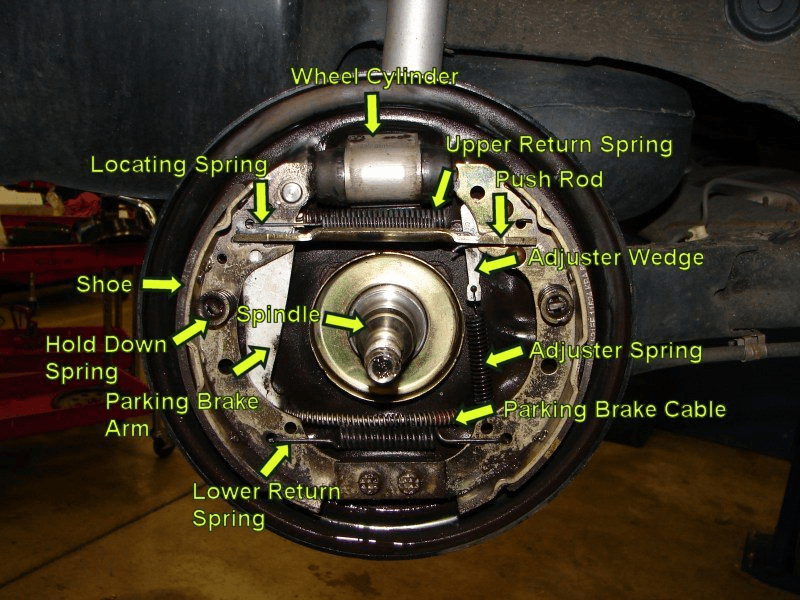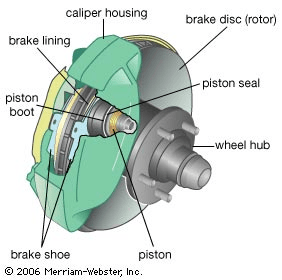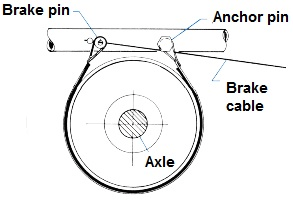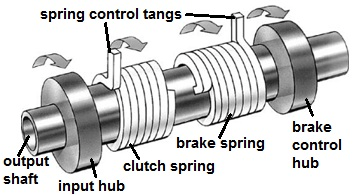Mechanical Brakes Information
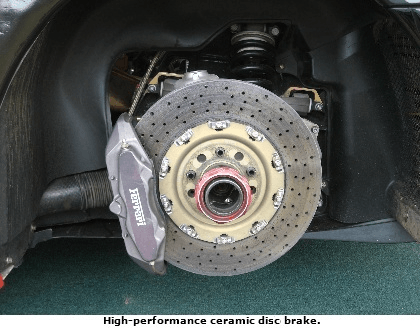 Mechanical brakes arrest the energy of a machine or object via force, most commonly friction. Most individuals are familiar with automotive brakes, but mechanical brakes are also essential in material handling, manufacturing, and other power transmission applications.
Mechanical brakes arrest the energy of a machine or object via force, most commonly friction. Most individuals are familiar with automotive brakes, but mechanical brakes are also essential in material handling, manufacturing, and other power transmission applications.
Mechanical brakes function via force delivered to a body in rotary or linear motion, such as an axle, shaft, or wheel, to slow or stop motion. Mechanical brakes are often in an assembly with a mechanical clutch for engaging and disengaging shafts. See the mechanical brake and clutch assemblies page for more specific data on these devices.
Friction-based brakes utilize a coarse and rugged material (i.e. brake liner) that is tightened or pressed against a body in motion to decelerate. Friction-based braking generates immense heat and some noise, degrading all of the engaged surface areas. Brake capacity decreases with every cycle and requires inspection and replacement. Friction-type brakes are heavily used in automotive applications.
Toothed brakes have tooth-shaped contact surfaces that transmit power without slippage or heat generation. Teeth are engaged only when stopped or running at slow speeds (<20 rpm).
Non-contact brakes use a technology such as a magnetic field or eddy currents to provide the braking action. Braking force is generated proportionately to velocity. An advantage of eddy current and magnetic brakes is that there is no friction, so there are no parts that wear out. A disadvantage of these brakes is that they do not have any holding force for stationary objects.
A wrap-spring clutch and brake works by connecting an input shaft and output shaft with an interference fit helical clutch spring. When the input shaft rotates in the direction of the wind of the clutch spring, torque is transmitted to the output shaft. A separate brake spring spins until the brake spring control tang is locked, which tightens the brake spring around the output shaft in position to a stationary brake hub that is bolted to a plate. Simultaneously the clutch spring releases. Wrap-spring brakes provide precise stopping (± 0.5°) in industrial machinery, but fully-mechanical wrap-spring clutches and drives are limited to smaller sizes; larger sizes are electromagnetic.
Types of Mechanical Brakes
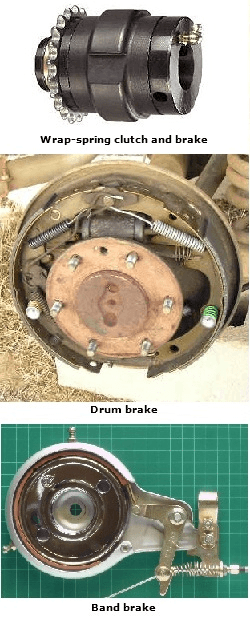 The following brakes are types of friction brakes.
The following brakes are types of friction brakes.
In drum brakes the brake lining is adhered to the external surface of a curved bracket, called a shoe. The most common configuration includes two shoes mounted inside of a drum on a plate. A cylinder presses the shoes onto the insides of the drum to initiate deceleration. A drum brake that presses on the outside of the drum is called a clasp brake; a double clasp brake applies braking pressure to both the inside and outside of the drum.
Cone brakes are a type of drum brake where the drum and shoe are mating sections of conical frustums. The shoe (i.e. cone) is outfitted with brake lining and pressed into the drum (i.e. cup) to apply friction. The advantage is increased surface area and quicker deceleration.
Disc brakes utilize a metal disc, also called a rotor, that is connected to the axle. The rotor spins between a caliper that contains between one and 12 cylinders, which pushes a lining material outfitted on a brake pad against the rotor surface.
An Ausco-Lambert disc brake utilizes two discs along with two 360° brake pads positioned inside the discs; one of the pads is stationary. Instead of pinching, the brake pads expand and initial contact between brake lining and disc is provided by actuators. Ball bearings are positioned between the brake pads in tapered recesses. When the pads expand the bearings ride the incline and jam the pads against each other, thereby providing additional, self-sustaining friction to the discs. When stopped the brakes auto-release. The Ausco-Lambert provides space savings, last longer, and run cooler, but are considered oversensitive. They have not been used on autos in 60 years.
Band brakes tighten a ribbon of high-friction material around a pulley attached to the rotating axle; they are often employed on bicycles. If the pull on the band is in the direction of axle rotation the brake is self-energizing. Differential band brakes attach both ends of the brake ribbon to the lever to supply braking power for bi-directional shafts.
Size and Weight
Size and weight are important considerations for mechanical brakes. They add weight to operations, require dedicated systems, and may need a power supply, but brakes are also overengineered to handle the maximum kinetic force that may be applied. Weight also adds to the inertia and dynamic torque experienced by wrap-spring brakes.
Common size considerations for friction brakes include:
- Disc/drum thickness - width of the friction surface engaged by the pad or shoe
- Disc/drum diameter - the cross-sectional distance of the disc or drum
- Total pad area - the square surface area of the brake pad or shoe
- Wearable friction area - the square surface area of the brake lining
- Bore size - the inner diameter for the disc or drum
- Bolt holes - the quantity and size for the bore holes used for axle attachment
- Running clearance - distance between brake lining and surface area when brakes are not engaged
- Lining thickness - the height of brake lining material
Wrap-spring brake geometries:
- Bore diameter - the inner diameter of the wrap-spring assembly
- Frame size - the nominative envelope size of the clutch and brake, typically between 2 and 45
- Diameter - the width across the cross-section of the spring assembly
- Number of stops - the quantity and degree intervals of stopping locations on the brake collar
- Thread engagement - depth of threaded bores for hardware on pulleys/hubs
Components
Common parts of applicable mechanical brakes are as illustrated.
|
Drum brake
|
Disc brake
|
|
Brand brake
|
Wrap-spring clutch/brake
|
Engagement
Friction Brakes
Significant force is required to decelerate components from friction. Brakes that rely solely on manual power supplied by the operator are the purest form of mechanical brake and many need to be self-energizing to be effective.
Dual-function brakes are those that utilize two sources for actuator power, such as pneumatic-mechanical or hydraulic-mechanical. For example, in passenger automobiles the operator depresses a pedal that compresses brake fluid in a linked master cylinder. The master cylinder converts this into hydraulic pressure that actuates the slave cylinders that ultimately provide the braking force. A vacuum servo often helps the driver obtain the foot pressure necessary to pressurize the hydraulic system. Similarly, large commercial vehicles often use pneumatic-mechanical braking systems (i.e. air brakes).
Lever force is the total available braking power from an individual system. This force must be sufficient to decelerate the shaft within a specified time (i.e. braking force).
Braking Torque Calculations
| Disc |  |
| Drum | 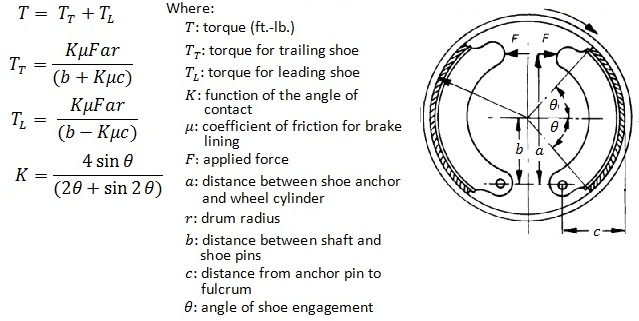 |
| Band | 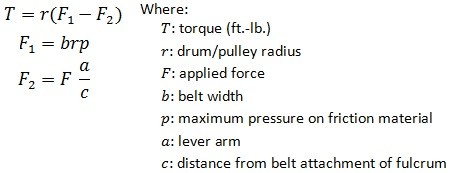 |
Wrap-Spring Brakes
In order to accurately start and stop a load, the shaft needs enough torque to engage the clutch spring, as well as enough inertia to engage the brake spring. Calculate the inertia (WR²) of all rotating components, including shafts, drums and pulley. A reference table will contain data on the inertia of steel shafting per inch of length of thickness, as well as conversion data for non-steel materials. To determine the inertia of hollow parts, first find the inertia of an equivalent solid part (outer diameter), then find the inertia of the hollow area as if it were a shaft (inner diameter). Subtract the inner diameter inertia from the outer diameter inertia, and multiply the per inch value by the length or thickness of the part.
Wrap-Spring Braking Calculations
| Torque required to engage output shaft | Minimum inertia to engage brake spring |
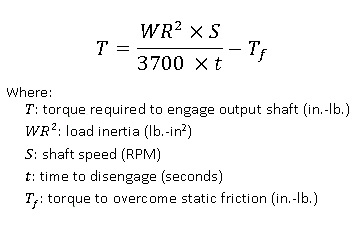 |
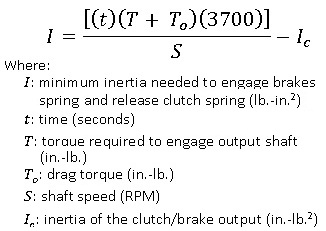 |
If the final value for the minimum inertia needed to engage the brakes spring is equal or less than 0, the brake spring has enough inertia to halt the shaft to the determined accuracy. Stop collars engage the brake spring and have one to 20 or more stop positions.
Thermal Management
The friction between brake pads and drum or disc surfaces translates kinetic energy into heat energy, a major concern to retain brake operability. Overheated brakes will transfer excess thermal energy to brake pads, which begin to deteriorate and thereby hasten brake fatigue. Serious overheating causes brake fluid vaporization that can lead to complete failure for disc brake systems. In drum brakes, the drum absorbs up to 95% of all heat generated, so shoes and linings do not experience the same extreme temperatures and brake fluid remains insulated against vaporization. Drum drilling is a technique that allows heat to escape holes created in the drum working surface.
Most disc brakes can exhaust about 3 BTU per hour per square foot of disc surface at 300° F, and higher speed discs can even exhaust up to 5 BTU per hour per square foot. Airflow from vehicle locomotion is often enough to cool disc brakes on vehicles. Discs that experience extreme temperatures or are on stationary equipment are subject to both passive (increased surface area, ventilation slots, multiple calipers, materials changes) and active (compressed air) solutions.
Band brakes have poor cooling capacities and suffer increased brake fade as a result.
Disengagement
Complete release of mechanical brakes results in brake drag that shortens braking components service life and also wastes energy. For many friction brakes, a spring holds the brake in the disengaged position until a force overcomes the spring preload. Brakes can also be supplied as fail-safe brakes, or brakes where the spring keeps the brake engaged and power is needed to remove the spring's braking force.
For band brakes, disengaging the brake requires loosening the brake band, which can be done automatically when the shaft is stopped (as with self-energizing brakes) or by releasing the brake lever or other activation mechanism. The brake spring in wrap-spring clutches and brakes automatically releases when the shaft has stopped.
Materials
Brake lining materials vary considerably by application. Materials must be soft, tough, heat resistant, and possess a high coefficient of dynamic friction. They are applied to pads or shoes made of welded or riveted sheet metal.
- Non-metallic - composite organic or synthetic materials, including cellulose, aramids, polyacrylnitrile, and sintered glass. Non-metallic linings minimize rotor wear, but have short service lives.
- Semi-metallic - composite materials filled with metallic flakes to improve wear resistance and service life with increased wear on the rotor or drum; requires higher braking torque.
- Metallic - often reserved for performance or high energy applications; composed of sintered steel that wears quickly on rotors, requires higher braking torque, and generates noise.
- Ceramic - clay and porcelain mixed with copper flakes and filaments. Moderate durability, lifespan, and torque requirements with zero perceived sound. However high operating temperatures can warp pads and other components.
Calipers are typically metal plates with cylinders made of plastic, aluminum, or chrome-plated steel. Disc materials include:
- Ceramic composite - carbon fiber-reinforced ceramic provides stable friction at high speed and all temperatures, is 50% lighter than grey iron, but is also quite expensive.
- Grey iron - cast iron with graphitic microstructure that has high heat and damping capacities with wear resistance and machinability. It is the most common material for automobile rotors.
- Steel - stainless steel is commonly integrated into bicycle and motorcycle brakes, however has poor thermal conductivity. Steel may be acceptable for applications with higher thermal requirements, but will also corrode.
- Aluminum - a lightweight metal with excellent thermal characteristics; only suitable for low RPM applications because of decreased wear resistance and strength; sometimes found on bicycles.
- Titanium - only compatible with organic or resin-based liners; lightweight with good strength and corrosion resistance, but has low surface friction and lifespan.
Some common drum materials are:
- Cast iron - the most common brake drum material
- Aluminum - lighter than iron with improved heat dissipation and brake fade; needs iron or steel liner to retain structural integrity
- Steel - steel shells are a common means to reduce weight and improve cast iron drum performance
- Composite - hybrid materials, such as cast-aluminum filled with silicon carbide, provides weight savings with adequate friction and wear resistance
Mounting
The operational components of drum brakes (spring, cylinder, and shoes) are affixed to a backing plate. It is a rigid, non-rotating bracket that is often attached to the axle sleeve. Disc brakes also utilize a backing plate, but its purpose is to minimize brake dust build-up and is sometimes optional.
Discs are mounted onto the axle, while calipers that contain the cylinder and pads are either fixed or floating. Floating calipers employ only one piston, so the caliper is supplied limited lateral movement with pins and bushings. The cylinder pushes a piston with a brake pad against the rotor, while this movement also draws the other side of the caliper—outfitted with a brake pad only—against the other side of the rotor. Fixed calipers include two pistons that press brake pads against opposite sides of the rotor simultaneously. Generally, floating calipers are less expensive, lighter, and just as useful for basic applications, however they are limited to a single piston. Fixed calipers apply pressure more evenly and can utilize up to 12 cylinders; they are more common on performance braking systems.
Band brakes are rather simple. The drum is attached to the axle, while the band is wrapped around the drum and one end is attached to a bolt or anchor point. The other end of the band is attached to a brake rod or other linkage. If both ends of the band brake are attached to linkages then it supports bi-directional braking.
Wrap-spring brakes are assembled on a rectangular backing plate that includes an actuator, a solenoid, and the clutch/brake assembly. The rectangular backing plate also includes four through-holes, however only one of these holes should be fixed to a non-rotating surface. Installing hardware in more holes than necessary does not allow the axial tolerance needed and results in reduced service life and braking inaccuracies for precision machines.
Regenerative and Dynamic Braking
Kinetic energy recovery systems (KERS) harvest wasted energy from braking operations and store it chemically in batteries, electrically in capacitors, or mechanically in a flywheel. KERS are especially common in hybrid-fuel vehicles.
On electrically-powered machinery, dynamic braking converts excess mechanical energy into thermal energy. If a shaft continues to rotate after power has been removed, excess voltage from the shaft could create an over-voltage fault. Excess electrical energy is distributed to resistors and heat sinks, and is sometimes used to power other applications.
Specifications
- Lever force - the total available force that a braking system can apply
- Response time - the lag between the braking command and engagement of the mechanism, typically in milliseconds.
- Braking capacity - the cumulative decelerative effect of brake pad surface area and actuator force (excluding variables such as road conditions, wind resistance, etc.).
- Speed - the maximum axle rotational speed compatible for a given mechanical brake, typically in RPM
- Power - the maximum horsepower (HP)
- Braking torque - the force needed to halt a disc or drum in a specific timeframe (ft.-lb.)
- Torque rating - maximum torque that can be applied to a rotating component in foot-pounds (ft.-lb.)
- Peak force - the maximum pressure that can be applied by the actuator
- Continuous power dissipation - the power that the brake can withstand before failing
- Brake lining service life - depends on force applied, material, cycling, and operating temperatures.
- Static torque - the force applied to the disc, drum, or shaft to prevent rotation when stopped or parked
- Tensile strength - wrap-springs can only transmit torque that doesn't exceed their material strength
- Torque-to-size ratio - the ratio of brake diameter to braking torque
- Anti-back/anti-overrun torque - torque to eliminate backward or bouncing movements by the shaft when stopped.
Features
- Dual function - a separate pressure system aids in delivering torque to the brakes
- Zero backlash - there is no tolerance during braking engagement
- Bi-directional - brakes can decelerate shafts rotating in either direction
- Slip indication - feedback that the braking system is not performing optimally
- Adjustable torque - a configurable setting for the torque applied
- Washdown - the brake system can be cleaned by hosing or pressure washing
- Feedback - brakes support a system for operations monitoring
-
Brake boost - supplements brake power by using the electronic stability control unit when the vacuum boost is insufficient
Standards
The Society of Automotive Engineers (SAE) is the preeminent standards body for automobiles and has several standards related to vehicle brakes. Other standards may reference industrial methods of shaft deceleration for power transmission applications.
SAE J431 — Grey iron castings
SAE J101 — Performance and durability of wheel cylinders for drum brakes
SAE J1713 — Determining strength and fatigue life of disc brake system for vehicles
Resources
Altra Industrial Motion—Warp Spring Clutches and Clutch/Brakes (.pdf)
Mounting a Wrap Spring Clutch/Brake;
Neo Motorsport—Fixed Caliper vs. Floating Caliper
Mechanical Engineer's Data Handbook—2.8 Brakes, clutches and dynamometers (via Google Books)
Thomason Linear—Selecting a Wrap Spring Clutch/Brake (PDF)
Machine Design—Getting up to speed with wrap-spring clutch/brakes;
Wikipedia—Band brake; Drum brake; Disc brake; Vacuum servo; Regenerative brake;
Image credits:
Dan's VW page via CCP.edu | Britannica | Azusa Engineering | Thomson Linear | Wikimedia | Machine Design
